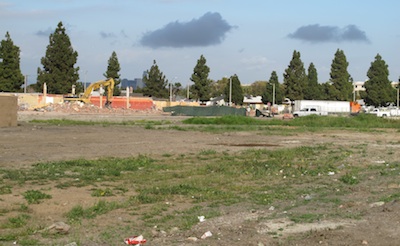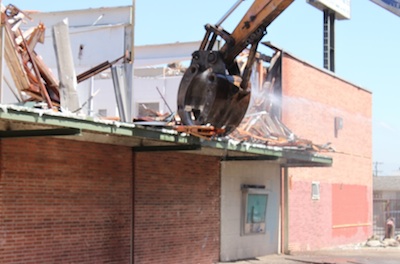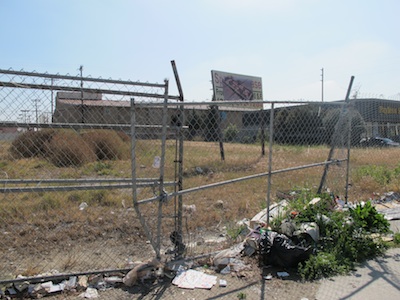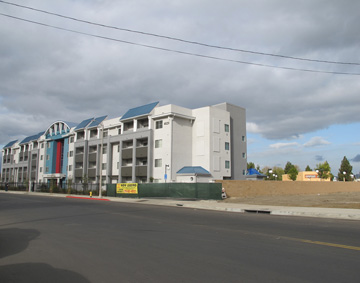
Demolition on Marlton Square isn’t complete. There has been no construction on the site for more than 20 years.
More than 20 years after the California Redevelopment Agency of the City of Los Angeles (CRA/LA) invested over $17 million dollars to buy portions of Marlton Square, it has yet to see new construction. The failed redevelopment project has become a monumental disaster and for many, an example of the CRA’s inefficiency.
The agency has been mired in controversy due to its slowness in handling funding and approval and construction of projects, prompting even the CRA’s toughest critics to face the prospect that the 20 acre property, which sits just feet away from the Baldwin Hills Shopping Center, will remain in an indefinite state of limbo.
Marlton Square, previously known as the old Santa Barbara Shopping Center, is just one of many South LA projects whose future prospects are uncertain due to the closure of the CRA on February 1st. With the elimination of the redevelopment agency, there’s no knowing how long it will take to determine which projects must continue, when they’ll be given a green light or how soon they can receive the money to move forward.
“It’s going to be very detrimental to communities across the state, particularly in L.A., in areas that are poor,” says District 8 Councilman Bernard Parks about the CRA closure. “The way it was cut off is going to be devastating. There was no planning for contracts or moving forward on projects.”
When Governor Jerry Brown last year called for the dissolution of the CRA, the state was facing a $19 billion deficit. Eliminating the CRA was meant to alleviate the state’s financial woes by bringing property tax revenues, which were diverted to local redevelopment agencies, back to the state.
“Even if the governor closed the budget gap it, won’t do anything to help communities in low income areas,” complains Parks. “Looking down the road, shutting the CRA is a decision people will live to regret.”

Demolition on Marlton Square began in August of 2011.
The dissolution of the CRA means the independent agency, once authorized to purchase property, raze and build structures, develop affordable housing and provide municipal infrastructure such as streets and lighting, had to stop everything it was doing.
Successor agencies have taken over the CRA’s responsibilities, which include approving projects that will move forward and selling all of its assets to pay outstanding debt.
Many of the projects already underway have what’s called enforceable obligations and must be completed. These obligations include binding contracts. Additionally, construction was made possible due to the selling of municipal bonds, which have to be repaid. Even though the CRA/LA technically no longer exists, it’ll take a while for it to wind down and comply with all of its legal obligations, including paying back all of its loans.
“According to state legislation, repaying the bondholders is an enforceable obligation, so we will have to do that,” states Carolyn Hull, South Los Angeles Regional Administrator for the CRA/LA.
The CRAs were set up so that taxes generated from projects in a specific area would be reinvested in the area it came from. So Parks worries how oversight boards foreign to the needs of South LA will be able to adequately address the community’s concerns.
“They’re going to auction properties without taking into account the time and money spent on the projects, and the monies received from those auctions will go to different cities in L.A. [county], not the areas where the project originated. It’s a disaster.”
Marlton Square is in Parks’ district, so he’s concerned about its future.
“Marlton Square was a tremendously difficult project to move forward with because of the multiple ownerships,” explains Hull. “There were over 40 owners and 30 tenants that had to be relocated.” She says another problem is “there was an agreement in place with the city and county saying the Crenshaw project area could only generate $500,000 a year in tax increment. Capping the income severely limited the ability to reinvest in the community.”
So even though, according to Hull, the Crenshaw project area generated a much larger tax increment, the CRA couldn’t touch that money. That forced the agency to look for alternative sources of funding to move the Marlton Square project forward, delaying the acquisition process of the property.
About 80 percent of the land Marlon Square sits on is owned by Commercial Mortgage Managers (CMM), which bought it from foreclosure in 2008. The CRA owns the rest. Since so much money has already been invested and plans for construction are underway, the project is considered an enforceable obligation, so it must be continued.
“There are several developers committed to the project,” says Purvi Doshi, Economic Development Deputy for Parks. “Several bids have come in and the CRA and CMM are in the process of reviewing them.”

This vacant lot was scheduled to be the Vermont Manchester Shopping Center, but numerous obstacles stalled the CRA project. Now, the fenced lot only collects garbage.
Doshi says as soon as a developer is chosen to purchase the property from CRA, the money from the sale will be used to pay off a $12.5 million HUD loan acquired in 2008.
The CRA estimates once development begins, Marlton Square would generate 700 to 800 construction and 550 permanent jobs.
Marlton Square may have a happy ending, after all. But the Vermont Manchester Shopping Center, another project Parks considered important and invested significant time and resources on, won’t make the cut. The four-acre lot has been vacant 20 years and it looks like it’ll stay that way.
“It has been an eyesore for the community,” says Doshi. In 2008, the CRA tried to buy the land from its owner, but they couldn’t reach an agreement. “We found CRA funds to go into eminent domain proceedings. We were supposed to start the court proceedings in January, but when the CRA ruling came in to dissolve, we had to abandon that.”
Plans for the project included construction of a supermarket, a sit-down restaurant, a drugstore and a bank – all considered to be necessities in the area. The estimated CRA investment for the project was $9.5 million. Hull says the development of the shopping center would have created 150 construction and 200 permanent jobs. Among the community benefits derived from being a CRA project: mandatory local hiring and prevailing wage requirements.
Parks says a mixed-use senior housing and grocery store on 38th and Vermont is also likely to stall. “Those are the kind of things we’ve worked on and were just about ready to percolate, but now, since there’s no binding contract, they’re on the cutting block.”
Despite the controversy surrounding the CRA, Parks is a firm believer that without the redevelopment agency, many improvements in South LA would not have been possible.
“The ability to pull together a project on 94th and Broadway, a senior housing and mixed-use project with a grocery store, these are things that wouldn’t be there.” He also points to the recent completion of the Buckingham Place senior housing project, near Marlton Square, which will soon start accepting applications for tenants to move in.

Buckingham Place, with Marlton Square on the right.
But the Buckingham Place project wasn’t a complete success. Originally part of the Marlton Square redevelopment project, it was set out to be a three building complex with 180 units. Construction was halted in 2008 after the original developer filed for bankruptcy. A second developer completed one building with 70 units in March of 2012.
Redevelopment agencies across the state received over $5 billion of tax increment revenues annually. The South LA region only got an operating budget of $20 to 25 million for nine project areas.
“It had the least amount of the regions in L.A. to put into projects,” states Hull.
It’s currently unknown what the overall economic impact of unfinished redevelopment projects will be in communities across the state in terms of jobs and reinvestment in blighted areas. In South LA, Hull estimates hundreds of temporary and permanent jobs will disappear, causing a negative chain reaction of losses among the different sectors of the local economy.















Speak Your Mind